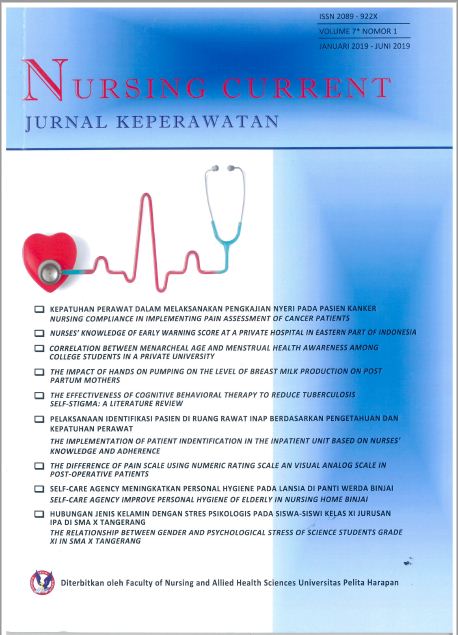SELF-CARE AGENCY IMPROVES PERSONAL HYGIENE OF ELDERLY IN A NURSING HOME IN BINJAI [SELF-CARE AGENCY MENINGKATKAN PERSONAL HYGIENE PADA LANSIA DI PANTI WERDA BINJAI]
DOI:
https://doi.org/10.19166/nc.v7i1.2225Schlagworte:
Elderly patients, Self-Care Agency, Personal HygieneAbstract
The Self-Care Agency role is to increase knowledge with changing attitudes in driving the elderly to be more aware of the importance of personal hygiene in their daily lives. One attempt in the prevention of disease in the elderly is by doing personal hygiene so that the elderly can better feel comfort, safety and well-being. This study aimed to determine the effect of Self-Care Agency to the personal hygiene of the elderly in nursing home Binjai. The design study is Quasi-Experimental Design Time Series, with the approach of One Group Pre Post Test Design. Sampling was done by purposive sampling with a sample of 30 respondents. Research results pre intervention personal hygiene less category as much as 73%, and post intervention personal hygiene category of "good" as much as 53.3%. Based on the results of the Wilcoxon test showed that the self-care agency signifikat to improving the personal hygiene of the elderly in Panti Werda Binjai, with p value = 0.001. Low personal hygiene of the elderly in nursing home Binjai due to lack of awareness of the importance of self care. It is necessary innovations in providing nursing interventions, assistance, support and cooperation with the nursing home attendant in improving personal hygiene of the elderly.
BAHASA INDONESIA Self-Care Agency berperan untuk meningkatkan pengetahuan dengan mengubah sikap dalam mengarahkan lansia untuk lebih menyadari pentingnya melakukan personal hygiene didalam kehidupan sehari-harinya. Salah satu usaha pencegahan penyakit pada lansia dengan melakukan personal hygiene sehingga lansia dapat merasakan kenyamanan, keamanan dan kesejahteraan yang lebih baik. Penelitian ini bertujuan untuk mengetahui pengaruh Self-Care Agency terhadap personal hygiene lansia di Panti Werda Binjai. Desain penelitian yang digunakan Quasi Experimental Time Series Design, dengan pendekatan One Group Pre Post Test Design. Pengambilan sampel dilakukan dengan dengan purposive sampling dengan besar sampel 30 responden. Hasil penelitan pre intervensi personal hygiene kategori kurang sebanyak 73%, dan post intervensi personal hygiene kategori “baik” sebanyak 53,3%. Berdasarkan hasil uji Wilcoxon memperlihatkan bahwa Self-care agency signifikan terhadap peningkatan personal hygiene lansia di Panti Werda Binjai, dengan nilai p value = 0,001. Personal hygiene yang rendah pada lansia di Panti werda Binjai disebabkan kurangnya kesadaran pentingnya perawatan diri. Maka perlu inovasi dalam memberikan intervensi keperawatan, pendampingan, dukungan dan kerjasama dengan petugas panti werda dalam meningkatkan personal hygiene lansia.
Literaturhinweise
Afaf, I. M. (2011). Theoretical nursing: Development and progress (5th ed.). Philadephia, PA: Lippincott Williams & Wilkins.
Andriyanti, L. (2018). Aplikasi Teori Dorothy Orem Dalam Pemberian Asuhan Keperawatan Pada Ny Y Dengan Kasus Infeksi Post Sectio Cesaria Di Rumah Sakit Kota Bengkulu. Journal of Nursing and Public Health, 5(2), 54-59. https://doi.org/10.37676/jnph.v5i2.577
Alligood, M. R. (2013). Nursing theorists and their work - E-book (8th ed.). St. Louis, MO: Mosby.
Astarani, K. (2018). Gambaran Kondisi Fisik Dan Pemenuhan Personal Hygiene Pada Lansia. 2017: Seminar Nasional dan Workshop Publikasi Ilmiah, 146-151. http://jurnal.stikesbaptis.ac.id/index.php/PSB/article/view/258
Carpenito, L. J. (2013). Buku Saku Diagnosa Keperawatan. Jakarta, Indonesia: EGC.
Chairil, & Hardiana. (1930). Gambaran Perilaku Personal Hygiene Pada Lansia Di Upt Pstw Khusnul Khotimah Pekanbaru. Photon: Jurnal Sain Dan Kesehatan, 8(1), 29-36. https://doi.org/10.37859/jp.v8i01.524
Hannan, M., & Puspitasari, D. I. (2018). Hubungan Perawatan Keluarga Dengan Personal Hygiene Pada Lansia Di Dusun Asem Nunggal Desa Kalianget Barat Kecamatan Kalianget. Wiraraja Medika, 7(2), 45-51. https://doi.org/10.24929/fik.v7i2.433
Pusat Data dan Informasi Kementerian Kesehatan RI. (n.d.). Infodatin situasi lanjut usia (lansia) di Indonesia. Retrieved August 14, 2014, from http://www.pusdatin.kemkes.go.id/article/view/16092300002/infodatin-situasi-lanjut-usia-lansia-di-indonesia.html
Muko, S. Y. M. (2014). Perbedaan Personal Hygiene Pada Lansia Di Panti Sosial Tresna Werdha Ilomata Dan Beringin Provinsi Gorontalo (Thesis, Universitas Negeri Gorontalo). https://repository.ung.ac.id/skripsi/show/811409059/perbedaan-personal-hygiene-pada-lansia-di-panti-sosial-tresna-werdha-ilomata-dan-beringin-provinsi-gorontalo.html
Nies, M. A., & McEwen, M. (2014). Community/Public Health Nursing - E-Book: Promoting the Health of Populations. Philadelphia, PA: Saunders.
Muhtar, A. H. (2016). Penerapan Asuhan Keperawatan Keluarga Dalam Meningkatkan Self Care Behavior Penderita Tuberkulosis Paru Di Kota Bima Nusa Tenggara Barat. Jurnal Kesehatan Prima, 10(1), 1579-1587.
Ramadhan, K., & Sabrina, I. K. A. (2016). Hubungan Personal Hygiene Dengan Citra Tubuh Pada Lansia Di Desa Sepe Kecamatan Lage Kabupaten Poso. Jurnal Kesehatan Prima, 10(2), 1735-1748.
Sari, N. P. W. P. (2017). Nursing Agency Untuk Meningkatkan Kepatuhan, Self-Care Agency (Sca) Dan Aktivitas Perawatan Diri Pada Penderita Diabetes Mellitus (Dm). Jurnal Ners Lentera, 5(1), 77-95.
Sekaran, U., & Bougie, R. (2016). Research nethods for business: A skill building approach. New York NY: John Wiley & Sons.
Sudarsih, S., & Sandika, D. R. (2017). Hubungan Antara Dukungan Keluarga Dengan Kemandirian Lansia Dalam Pemenuhan Personal Hygiene Di Desa Prajekan Kidul Bondowoso. Jurnal Keperawatan Bina Sehat, 14(2).
Suhardingsih, A. S., Mahfoed, M. H., Hargono, R., & Nursalam, N. (2017). The Improvement Of The Self-Care Agency For Patients With Ischemic Stroke After Applying Self-Care Regulation Model in Nursing Care. Jurnal Ners, i(1), 13-23. https://e-journal.unair.ac.id/JNERS/article/view/3994
Downloads
Veröffentlicht
Zitationsvorschlag
Ausgabe
Rubrik
Lizenz
Authors who publish with this journal agree to the following terms:
1) Authors retain copyright and grant the journal right of first publication with the work simultaneously licensed under a Creative Commons Attribution License (CC-BY-SA 4.0) that allows others to share the work with an acknowledgement of the work's authorship and initial publication in this journal.
2) Authors are able to enter into separate, additional contractual arrangements for the non-exclusive distribution of the journal's published version of the work (e.g., post it to an institutional repository or publish it in a book), with an acknowledgement of its initial publication in this journal.
3) Authors are permitted and encouraged to post their work online (e.g., in institutional repositories or on their website). The final published PDF should be used and bibliographic details that credit the publication in this journal should be included.

This work is licensed under a Creative Commons Attribution-ShareAlike 4.0 International License.






